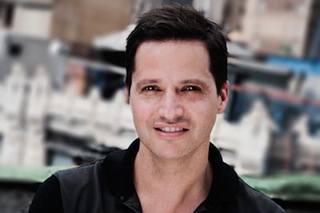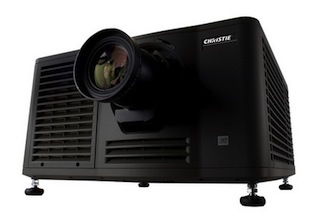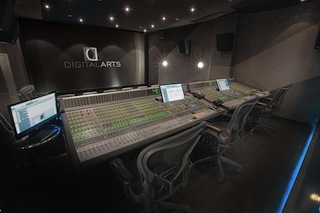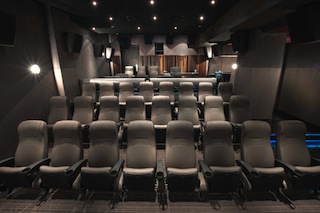 Digital Arts NY, located in the heart of New York City, provides picture and sound finishing services for feature films and high-end TV productions within its 12,000 square foot facility. The company recently launched what Axel Ericson, the founder and owner, feels is the first true 4K infrastructure on the East Coast for full 4K digital cinema finishing, including a new, landmark audio mixing environment. The sound for Woody Allen’s latest film, Blue Jasmine, was mixed in the room.
Digital Arts NY, located in the heart of New York City, provides picture and sound finishing services for feature films and high-end TV productions within its 12,000 square foot facility. The company recently launched what Axel Ericson, the founder and owner, feels is the first true 4K infrastructure on the East Coast for full 4K digital cinema finishing, including a new, landmark audio mixing environment. The sound for Woody Allen’s latest film, Blue Jasmine, was mixed in the room.
Though there is at least one other New York post house that does 4K editing, there is also some justification for Ericson to make his claim. The centerpiece of his screening room is a Christie 4K CP4220 digital cinema projector and the heart of that projector is a literally one-of-a-kind lens. Dr. Don Shaw, Christie’s senior director of product management, entertainment solutions, told me the story of the unique lens for Digital Arts’ 4K projector.
Shaw says Ericson is “quite a demanding customer” but he says it admiringly and out of respect. “He contacted us eighteen months ago,” Shaw continues, and said that he was building a 4K screening room and editing suite and wanted a Christie 4K projector. Understanding that the lens is, perhaps, the single most important to any projector, Ericson said he wanted the very best one available. In part because this was one of Christie’s first 4K post customers, Shaw took on the lens selection personally.
Although all lenses for high-end 4K projectors are of superior quality, each lens has its own characteristics. There can be inherent differences in apertures and focus, differences that are typically not noticed by the average movie goer but are easily noticed by talented cinematographers and colorists, people who have the ability to see nuances and details that most of us can’t.
 For the projector at Digital Arts, Shaw says, “We hand picked Axel’s lens to find one with a more uniform focus.” Coupled with the Christie projector, which is perfectly placed in the screening room for optimum efficiency, the Konica lens delivers an image that is as sharp and clean as any I’ve ever seen. “A lot of things came together,” says Shaw. “The stars aligned for Axel.”
For the projector at Digital Arts, Shaw says, “We hand picked Axel’s lens to find one with a more uniform focus.” Coupled with the Christie projector, which is perfectly placed in the screening room for optimum efficiency, the Konica lens delivers an image that is as sharp and clean as any I’ve ever seen. “A lot of things came together,” says Shaw. “The stars aligned for Axel.”
Ericson, is a technology pioneer who has more than 25 years of experience in sound design, mixing, color grading and finishing. During his career Ericson has received numerous accolades – MTV, Emmy, Promomax/BDA and Monitor awards, and a Grammy nomination. Under his auspices, Digital Arts created one of New York’s first HD infrastructures and became the finishing house for major TV brands including National Geographic, A&E, ABC, Disney, HBO and many more. I recently interviewed Ericson about his company in general and 4K in particular.
Digital Cinema Report: The majority of broadcasters around the world still work in SD and have yet to make the transition to HD. The theatres that have switched to digital largely project 2K. Given that, please can you make the case for working in 4K?
Axel Ericson: There’s no doubt that with 4K, you will have a high-quality show today, while retaining high-quality source files for future use. Artistically, 4K can enhance storytelling, and producers have to balance how much extra value 4K is going to add to their movie today by giving it further life in years to come.
Although 4K is not yet a standard delivery requirement, there are several trends, when taken as a whole, that are building significant momentum towards 4K. When you look at technology choices, most people tend to underestimate the power of exponential growth. At this point in time, the progression of camera sensor/projector chipset technology is pretty much following Moore's Law. Within a short timeframe, 4K will become the norm. Exhibitors who made choices about 2K will certainly have to reassess their decisions.
 On the consumer end, I think the growth will be driven by the convergence of computing and TV sets. The latest computer GPUs are now able to drive 4K displays, creating a substantially improved experience on computer displays, where you can see every pixel at its full potential resolution. For 4K content itself, webcasters, like Vimeo and YouTube, and major broadcast milestones, such as the World Cup, will lead the way, as well as content with a loyal fan base willing to pay for 4K, such as concert events. I expect the trend of this last phase to emulate what we experienced during the HD transition. Gaming is likely to be another driving force.
On the consumer end, I think the growth will be driven by the convergence of computing and TV sets. The latest computer GPUs are now able to drive 4K displays, creating a substantially improved experience on computer displays, where you can see every pixel at its full potential resolution. For 4K content itself, webcasters, like Vimeo and YouTube, and major broadcast milestones, such as the World Cup, will lead the way, as well as content with a loyal fan base willing to pay for 4K, such as concert events. I expect the trend of this last phase to emulate what we experienced during the HD transition. Gaming is likely to be another driving force.
DCR: What are the biggest challenges of shooting in 4K?
AE: Whatever the choice of format – celluloid or digital – filmmakers want to give their story an appropriate, or distinctive, visual look and feel. If they choose 4K, they need to consider how the extra resolution they are getting can be best used artistically. 4K is an extremely sharp and precise medium, so decisions such as the choice of lenses, filtration and grain become critical. Different production departments need to take into consideration the effects of the 4K camera and lens combination on things like skin detail and make-up, wardrobe, set details, focus, depth-of-field etc.. We have seen beautiful 4K content shot with older lenses that has given a particular look, and delivered a softness to the image that avoids revealing flaws and artifacts that more modern lenses might produce. On the other hand, we’ve also seen spectacular 4K material, shot using sharper, modern lenses, where the artistic choice has been to create impact by revealing lots of detail. We welcome the opportunity to collaborate with filmmakers from the very early stages – as they perform camera tests right and right through principal photography – to help them get the final results they want.
Whatever the format, it’s also vital to ensure the integrity of the visual look – that the cinematographer, director and the filmmaking crew strive to achieve – from the set, through post, and to the final deliverables. This means establishing a consistent end-to-end color pipeline. So it’s advisable to discuss this with the DI post facility in advance too.
A big advantage with 4K is that you can make and control a number aesthetic choices in post production. For example, you can frame wider on-set so that things like stabilization and final framing can be controlled in the DI theater. With cameras like Red, this decision can still be made in a 4K finishing pipeline as the sensors have extra resolution beyond 4K.
 There’s a presumption that there’s a higher cost of 4K in post. If you’re shooting mainly live action, and don't have a lot of VFX in your movie, then 4K can be far more cost-effective than you might think. We can de-Bayer 4K camera formats on-the-fly in post and you can work in realtime 4K with a full 444 pipeline – making it much more affordable than a DPX workflow, and bringing 4K within reach of many. Some adopters of 4K scene-to-screen features are going to emerge from lower-tier, lower-budget markets, as well as the higher-budget blockbusters. However, cost is most noticeably a hindrance to VFX projects where 4K increases rendering times.
There’s a presumption that there’s a higher cost of 4K in post. If you’re shooting mainly live action, and don't have a lot of VFX in your movie, then 4K can be far more cost-effective than you might think. We can de-Bayer 4K camera formats on-the-fly in post and you can work in realtime 4K with a full 444 pipeline – making it much more affordable than a DPX workflow, and bringing 4K within reach of many. Some adopters of 4K scene-to-screen features are going to emerge from lower-tier, lower-budget markets, as well as the higher-budget blockbusters. However, cost is most noticeably a hindrance to VFX projects where 4K increases rendering times.
DCR: What are the biggest challenges of posting in 4K?
AE: The 4K data set, being so large, is by far the biggest challenge – which is why we’re constantly upgrading our SAN. SAN speeds have now reached the required, sustained bandwidth for 4K (about 1.2GB/sec), but are still a bit low for a true 4K, uncompressed, shared environment.
DCR: What are the most common questions your customers ask you about working in 4K versus more established formats?
AE: 4K being new, there is an overall need for education for customers. Most people have not seen or experienced 4K yet, but there is a lot of curiosity about it, and their questions tend to range across different aspects of production, post-production and deliverables. Often clients may not look at their deliverable requirements in minutiae. How is the content going to be played in 4K after they’ve done the finishing? There is not yet a standardized pipeline where every vendor in the chain is 4K-ready. It really serves each project to have discussions with their 4K post-production facility before anything has been shot. In this way we can make a significant contribution to the whole pipeline and help them to avoid any pitfalls. When we are asked about a 4K finish, we are extremely thorough and test the client-specific parts of the pipeline beforehand. We very often take the role of post-producers and break things down to every detail to make sure that any potential issues are addressed early on.
DCR: What 4K tools would you like to see introduced or improved?
AE: I’d like to see advances in 4K scopes, and more 4Kplayback devices on the market. Overall, I’d like to see standardization of the 4K pipeline, and we need more manufacturers to get on board with this.
DCR: What have been your most successful 4K projects to date?
AE: Word about the advantages of 4K is definitely out there, and since launching our 4K DI facility we’re talking to a number of filmmakers about new projects they have on the blocks. It’s a little too early to discuss these in detail at the moment, but we’ll be back.
Digital Arts NY www.digitalartsny.com
